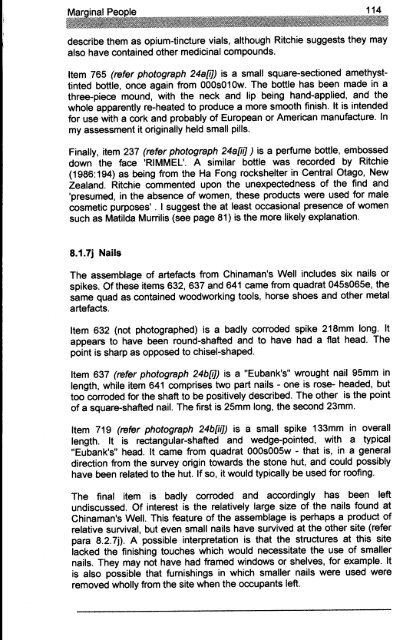Adec Preview Generated PDF File - The Sydney eScholarship ...
Adec Preview Generated PDF File - The Sydney eScholarship ...
Adec Preview Generated PDF File - The Sydney eScholarship ...
Create successful ePaper yourself
Turn your PDF publications into a flip-book with our unique Google optimized e-Paper software.
describe them as opium-tincture vials, although Ritchie suggests they may<br />
also have contained other medicinal compounds.<br />
Item 765 (refer photograph 24a[i)) is a small square-sectioned amethysttinted<br />
bottle, once again from 000s010w. <strong>The</strong> bottle has been made in a<br />
three-piece mound, with the neck and lip being hand-applied, and the<br />
whole apparently re-heated to produce a more smooth finish. It is intended<br />
for use with a cork and probably of European or American manufacture. In<br />
my assessment it originally held small pills.<br />
Finally, item 237 (refer photograph 24a[ii) ) is a perfume bottle, embossed<br />
down the face 'RIMMEL'. A similar bottle was recorded by Ritchie<br />
(1986:194) as being from the Ha Fong rockshelter in Central Otago, New<br />
Zealand. Ritchie commented upon the unexpectedness of the find and<br />
'presumed, in the absence of women, these products were used for male<br />
cosmetic purposes' . I suggest the at least occasional presence of women<br />
such as Matilda Murrilis (see page 81) is the more likely explanation.<br />
8.1.7j Nails<br />
<strong>The</strong> assemblage of artefacts from Chinaman's Well includes six nails or<br />
spikes. Of these items 632, 637 and 641 came from quadrat 045s065e, the<br />
same quad as contained woodworking tools, horse shoes and other metal<br />
artefacts.<br />
Item 632 (not photographed) is a badly corroded spike 218mm long. It<br />
appears to have been round-shafted and to have had a flat head. <strong>The</strong><br />
point is sharp as opposed to chisel-shaped.<br />
Item 637 (refer photograph 24b[i)) is a "Eubank's" wrought nail 95mm in<br />
length, while item 641 comprises two part nails - one is rose- headed, but<br />
too corroded for the shaft to be positively described. <strong>The</strong> other is the point<br />
of a square-shafted nail. <strong>The</strong> first is 25mm long, the second 23mm.<br />
Item 719 (refer photograph 24b[ii)) is a small spike 133mm in overall<br />
length. It is rectangular-shafted and wedge-pointed, with a typical<br />
"Eubank's" head. It came from quadrat 000s005w - that is, in a general<br />
direction from the survey origin towards the stone hut, and could possibly<br />
have been related to the hut. If so, it would typically be used for roofing.<br />
<strong>The</strong> final item is badly corroded and accordingly has been left<br />
undiscussed. Of interest is the relatively large size of the nails found at<br />
Chinaman's Well. This feature of the assemblage is perhaps a product of<br />
relative survival, but even small nails have survived at the other site (refer<br />
para 8.2.7j). A possible interpretation is that the structures at this site<br />
lacked the finishing touches which would necessitate the use of smaller<br />
nails. <strong>The</strong>y may not have had framed windows or shelves, for example. It<br />
is also possible that furnishings in which smaller nails were used were<br />
removed wholly from the site when the occupants left.




